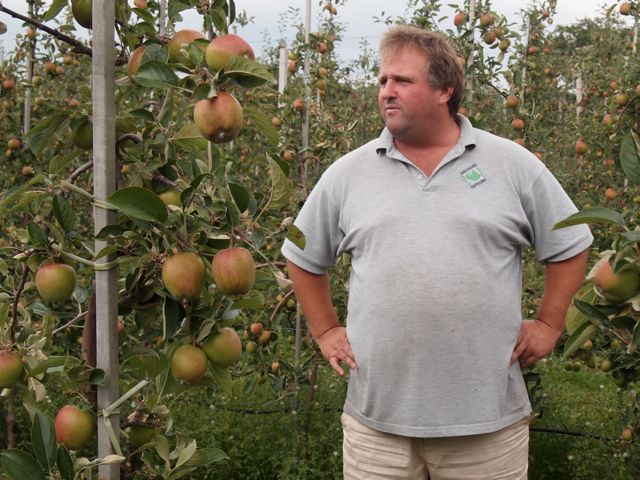
Young 'Regina' cherry orchard on Gisela 5 rootstock

Pondering the Bramley apples...

Tony Sunnucks in 'concept' apple orchard

Peter Hall, organic grower of apples, wine grapes, and hops
| To start off Day 2, we visited Oliver Doubleday, Managing Director, G. H. Dean & Co., a 150-year-old brick-making (literally) family farm. Although we first saw older cherry orchards of mixed varieties — ‘Bradbourne Black’ for example, which were still on the trees and quite tasty! — of medium to large tree size on Colt rootstocks, cherry orchards are being replanted to dwarfing Gisela 5 rootstocks with non-cracking varieties like ‘Regina’ (60% of the new orchard), Kordia,’ and ‘Karina.’ For example, we visited a newly planted 8 hectare block (right). Doubleday also expressed an interest fruit quality enhancement with modified atmosphere storage/packaging of cherries to extend the marketing season. |
|
|
Afterwards we were at the 350 acre Broadwater Farm for a tour of their orchards and fruit landing by Peter Checkley. The orchard is largely based on M.26 rootstock planted at app. 700 trees per acre. Of interest was the fact they were already picking and selling ‘Bramley’ apples, a large green apple popular in the U.K. for applesauce and pies. Here, left to right, a Boradwater employee, Bill Dodd, Phyllis and Mo Tougas, and Geraldine Warner appear to be thinking “now what?” with those Bramley apples? Fortunately, Checkley says they are doing very well with Gala apples in the U.K. now, something we could better relate-to. |
| A Day 2 afternoon tour of the ‘Concept Apple Orchard’ planted in 2006 at the Rankins Farm by Tony Sunnucks (J. R. Sunnucks) commenced. The ‘Concept’ orchard is an industry-sponsored, 1 X 3 meter planted to Gala, Braeburn, and Cox Orange Pippin among others. Sunnucks noted that Cox Orange Pippin was the #1 apple in England, but it has been replaced by Gala. Fruit quality and apparent yields here were impressive, with target yields of 60 tonne/hectare (app. 1,300 boxes/acre) probably being realized here in the 6th-leaf. |
|
|
Wednesday morning, Day 3, we drove out into the country town of Marden to see Peter Hall (H. E. Hall & Son), organic growers of apples, wine grapes, and hops. His apple production is split 50/50 between organic desert (Gala, Braeburn) and Bramley apples. Hall says he prefers the ‘science and technology’ vs. ‘muck and magic’ approach to growing organic apples, and he says “organic apples are much easier to grow intensively.” He goes on “timing is everything,” relying on predictive models to control scab with liquid sulfur sprays and insecticidal soap for sucking insects (rosy apple aphids) and mating disruption for codling moth. Most concurred that Hall’s organic apple orchard was the nicest ever seen! |
For more pictures, see the Day 2 and 3 gallery. Or view on Flickr
©2011 Jon Clements and the UMass Fruit Advisor
(Reporting for American/Western Fruit Grower)